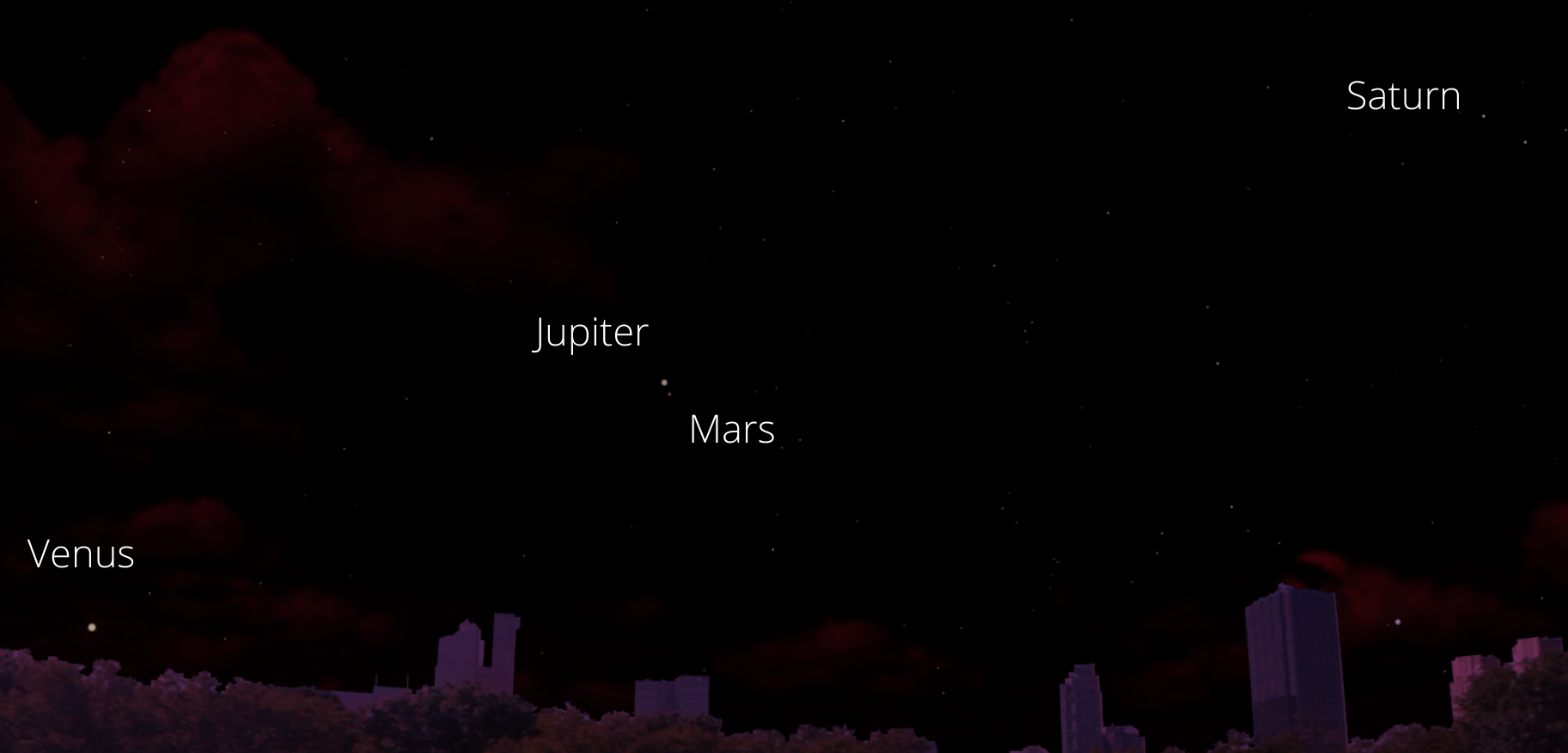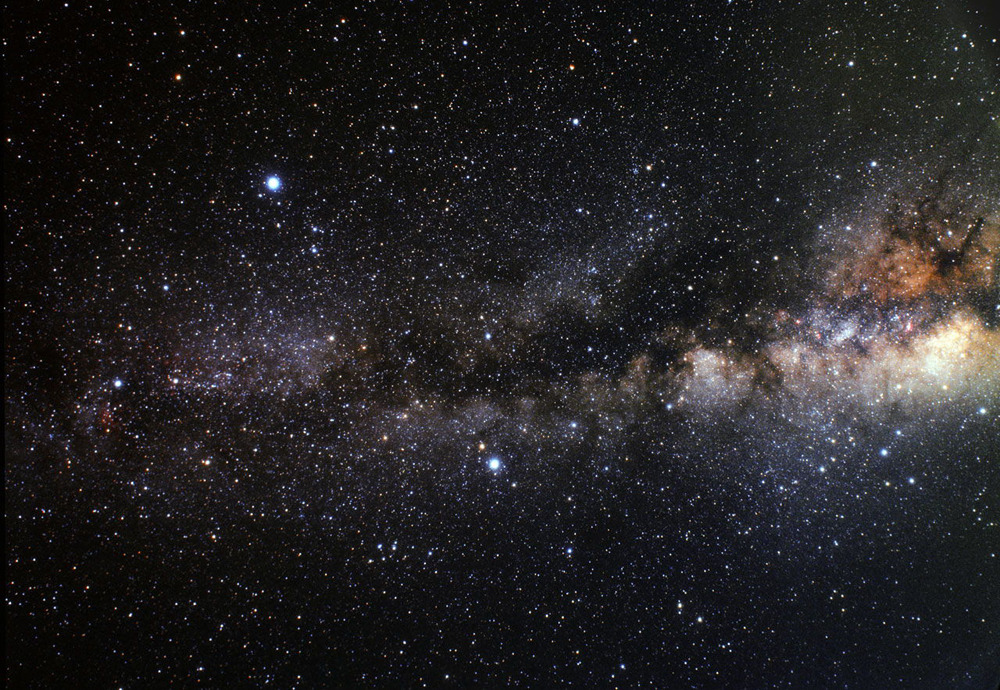If I See a New Moon Today When Am I Going to See It Again
May new moon 2022: A Black Moon for some with Jupiter near Mars

The new moon occurs on May 30, at 07:30 a.k. Eastern Daylight Time (1130 GMT), in New York, according to the U.Due south. Naval Observatory. This volition be, for some regions, the second new moon of the calendar month, sometimes called a "blackness moon." It will be a mean solar day after a close approach between Jupiter and Mars, so skywatchers on the nighttime of the New Moon will nevertheless see them placed shut together in the sky.
New moons occur when the moon is directly between the Earth and sun, and the two share their celestial longitude, a project of the Earth'southward longitude lines on the sky. This position is also known every bit a conjunction.
If 1 could come across the dark sky during the day, the moon would only be noticeable as it blocked out stars. Just the sun is then bright that it makes that kind of observation impossible from Globe. (The exceptions are solar eclipses. in which the moon passes direct in front end of the sun, but will non happen until October).
Related: Blue Moon: What is information technology and when does it occur?
Considering the moon takes only 28.5 days to make a excursion of the Earth, and May is 31 days long, some places will see the second new moon of the calendar month. This is considering the timing of lunar phases depends on the position of the Moon, so the local fourth dimension a moon becomes new, total, or enters the quarter phases depends on one'south time zone.
The last new moon was on April 30 for time zones in the Western Hemisphere (roughly from Hawaii to Baghdad) and on May one for time zones from Islamic republic of iran to New Zealand and the Pacific islands on the western side of the International Date Line. This full moon volition exist on May xxx for the entire globe, and then those places that got a May 1 new moon will get a second.
Visible planets

On the day of the New moon, the dominicus rises in New York at v:28 a.k. local time; sunrise will be close to that in mid-northern latitudes generally (in Washington DC it will be at 5:45 a.m., and in Seattle sunrise is at 5:17 a.k.).
From New York, past about four:30 a.m., one will meet Venus, Jupiter, Mars, and Saturn forming a rough line from east to southeast. Venus volition be the lowest (and brightest), at about 8 degrees in a higher place the horizon almost due due east. Turning southwards (to the correct) and moving upwardly, one will spot a "double star" that is in fact 2 planets — Mars and Jupiter. Both will be about 21 degrees loftier.
Moving further upwardly and to the correct ane will then see Saturn, nigh due southeast, about xxx degrees above the horizon. Jupiter and Mars will undergo a conjunction on May 28, passing inside about 38 minutes of arc of each other — a bit more than than a lunar bore. Both planets will rise that day by well-nigh 2:41 a.chiliad. in New York — the actual moment of conjunction isn't until later that 24-hour interval at viii:03 p.m., after both planets take set. While the two volition be in conjunction on May 28, they will make a closer approach on May 29, at 6:26 a.k. Eastern Time, when they will exist within 34 minutes of arc. This will be afterward sunrise for the eastern half of the U.Due south., but from Los Angeles, for example, the close arroyo will occur 3 hours earlier (3:26 a.thou. Pacific Daylight Time) subsequently the 2 planets have risen and well before sunrise (which is at 5:43 a.thou.)
Mercury rises at 5:06 a.m. in New York, and it will be hard to spot as the sky brightens — the planet will only get 4 degrees above the horizon by sunrise. It is of import to be very cautious when trying to catch planets (or other objects) close to the sunday — looking through binoculars or opera glasses at the sunday tin fire retinas and cause permanent impairment and even incomprehension. (This can happen even when using sun filters lifted from eclipse glasses because lenses intensify the lite).
In the Southern Hemisphere, the planets volition make a more "vertical" line in the predawn skies. In Cape Town, where the new moon occurs at one:xxx p.k. local fourth dimension on May 30, sunrise is at 7:41 a.m. local time, so the sky will exist dark enough to see stars until about 7:15 a.m. (nautical twilight, when the sun is between 6 and 12 degrees beneath the horizon is from half-dozen:43 a.thou. to 7:14 a.m.).
Venus, Jupiter, Mars and Saturn volition all brand a line that runs slightly northward from the east-southeastern horizon, towards the zenith. Venus is the last to ascent, at well-nigh 4:43 a.m. local time, and by 6:30 a.m. it volition be a full twenty degrees above the northeastern horizon. Looking further upwardly and slightly to the left (northwards) one will see Mars and Jupiter, both most 46 degrees loftier and then Saturn, which will exist 70 degrees high in the constellation Capricorn.
Constellations: Northern Hemisphere
In mid-northern latitudes, summer approaches, and it doesn't go fully dark until virtually nine:30 p.g. in New York City or Chicago (dusk is at eight:17 and 8:nineteen p.thou. local time in those cities). In Madrid, daylight savings extends dusk to ix:37 p.yard. local time, and in Istanbul, the sun sets at 8:28 p.m. (All of these cities are about 40 degrees northward.)
Past 10 p.m., the brightest winter stars are fully below the horizon. Only Castor and Pollux, marker the heads of the famous Twins (Gemini), will nonetheless exist visible depression in the southwest. In the East, i will run across Vega, the alpha star of Lyra the Lyre, and Deneb, the brightest star in Cygnus, the Swan, and Altair, the eye of the Eagle above the horizon. These three stars brand up the asterism (a group of stars that isn't an official constellation) called the Summertime Triangle. The trio makes a rough right triangle whose narrowest point faces southward, and so it is a good direction finder especially as it gets college in the heaven, much similar another asterism, the Big Dipper.

Looking southeast 1 will see Antares, the brightest star (the "center") of Scorpius, the legendary scorpion that killed Orion, the Hunter. Above Scorpius from dark-sky sites is the fainter (but much larger) constellation Ophiuchus, the Ophidian Holder or Healer. Ophiuchus can be recognized by a long trapezoid of medium-to-faint stars that extends above Scorpius; before midnight he will appear to exist lying on his side.
On either side of Ophiuchus are the constellations Serpens Head and Serpens Cauda, the head (Caput) and the tail (Cauda) of the serpents that Ophiuchus holds. Ophiuchus, also named Asclepius by the aboriginal Greeks, was the healer who brought Orion dorsum to life afterward the Hunter was bitten by the Scorpion. According to fable, Orion claimed he could impale whatsoever living creature, and Gaia, the goddess of the Earth, sent a scorpion to kill him. Asclepius went to heal Orion, and was so skilled he brought the hunter back to life. Hades, the god of the underworld, complained to Zeus that humans had the potential to become immortal, so Zeus struck both Asclepius and Orion downward and placed them amidst the stars. To this day, Asclepius (as Ophiuchus) stands higher up the Scorpion, and to prevent further trouble they are on opposite sides of the sky.
Looking northward, past 10 p.one thousand. one volition see the Big Dipper in the upper left quadrant of the sky (to the west of n), with the bowl upside down and the two stars that point to Polaris, the pole star, on the left side of the basin. The stars are called Dubhe and Merak, and Dubhe will be the 1 closer to Polaris. Following the handle of the Dipper ane can "arc to Arcturus" — a sweeping motion forth the bend of the handle gets you at that place, to the brightest star in Boötes, the Herdsman. If one draws a line betwixt Arcturus and Vega, in that location are two constellations. One is Corona Borealis, the Northern Crown, but to the east of Boötes, and eastward of that is the "keystone" — the four stars that make up the body of Hercules.
Constellations: Southern Hemisphere
In the southern hemisphere, winter is approaching. In Cape Town, the lord's day sets early, at 5:45 p.k. local time on May 30, and in Melbourne, Australia, the lord's day sets at five:10 p.grand. local time. That means the sky gets dark enough to come across stars by 6 p.m. Past 7 p.m., observers in mid-southern latitudes can run into the Southern Cantankerous high in the southeast, and simply below it, Alpha Centauri (Rigil Kentaurus), the brightest star in Centaurus the Centaur and the Lord's day's closest stellar neighbor. Scorpius — "upside downward" from the point of view of Antipodeans — will be rising in the southeast lower to the horizon. A fainter constellation just above Scorpius and to the left (e) of Centaurus is Lupus, the Wolf.
In the southwest, as one looks to the right of the Cross and Centaurus are the constellations Puppis, Vela and Carina, respectively the Poop Deck, Sail and Keel of the legendary ship Argo (at one fourth dimension the 3 constellations were seen as a single entity, called Argo Navis, merely since then astronomers have divided them). The brightest star in Carina is Canopus. Below and to the left of Canopus is the Large Magellanic Deject, a satellite galaxy of the Galaxy.
The Due south Celestial Pole is in the constellation Octans, the octant. In that location'south no southern "pole star" — Polaris' alignment with the North Celestial Pole is happenstance. One manner to locate the Pole is to use the "pointers" in Centaurus, Alpha and Beta Centauri. Centaurus is the constellation just beneath the Cross in the sky, and Blastoff and Beta are its 2 brightest stars. Ane draws a line from halfway betwixt those two and some other bright star, Achernar, the end of the River. The halfway point marks the pole.
Editor'southward Note:If you snap an amazing night sky picture and would like to share information technology with Space.com'south readers, send your photos, comments, and your name and location tospacephotos@space.com.
You can follow Space.com on Twitter @Spacedotcom and on Facebook .
Join our Space Forums to proceed talking space on the latest missions, dark sky and more! And if you take a news tip, correction or annotate, let us know at: customs@space.com.
Source: https://www.space.com/17561-new-moon-explained-lunar-phases.html
0 Response to "If I See a New Moon Today When Am I Going to See It Again"
Post a Comment